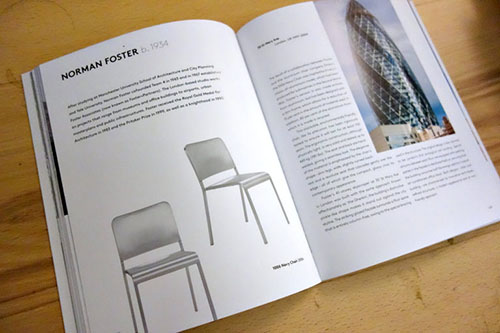“The relationships and similarities are often surprising, and raise some interesting questions,” Toromanoff writes in an introduction. “What is it that distinguishes a chair designed by an architect, rather than a furniture designer? Why would an architect want to design one? Is it possible to apply the creative solutions used for buildings to the design of furniture?”
The reasons are quite varied, especially as the relationship of the architect to the chair has changed. In the late 19th through to the mid-20th century, it wasn’t uncommon for an architect to design every piece of a structure, inside and out. Frank Lloyd Wright, for instance, would plan a house right down to its light switches, each element sharing his distinct aesthetic. His 1946 Taliesin West Chair, created for his home and studio in Scottsdale, Arizona, is built from one piece of laminated birch, seeming to be folded like origami. It was made three years after his Guggenheim Museum in Manhattan, itself appearing to be one fluid, curving shape. Likewise, Eileen Gray’s 1927 Roquebrune chair with its elegant, tubular legs and suspended leather seat harmonizes with her masterpiece: the E1027 House in Roquebrune-Cap-Martin, France.
Pages from ‘Chairs by Architects’ (photo of the book for Hyperallergic)
Pages from ‘Chairs by Architects’ (photo of the book for Hyperallergic)
Other chairs were made with specific purposes in mind, demonstrating the architect’s skill for functionality on a small and large scale. Josef Hoffmann’s 1905 “machine for sitting” for the Sanatorium Purkersdorf in Austria has a beautiful geometric shape similar to buildings like his 1911 Palais Stoclet in Brussels, but can also be easily reclined for patients. Alvar Aalto’s 1931 No. 41 chair made for the Paimio Sanatorium in Finland has a sweeping seat to allow easy breathing for those afflicted by tuberculosis, a graceful attention to usability shared by his 1971 Finlandia Hall in Helsinki. And almost all of the chairs reflect an architect’s appreciation for raw materials; Jean Prouvé’s 1934 Standard Chair austerely uses wood and steel, similar to his 1945 Maison Démontable 8×8 with its prefabricated parts. Mies van der Rohe’s famed 1929 Barcelona Chair is inspired by both modernism and ancient Egyptian thrones, the two-part steel frame with its leather upholstery having as much clarity in its design and exposed materials as his glass and metal Neue Nationalgalerie in Berlin.
The 160-page publication is arranged roughly chronologically, with very brief text, chased by interviews with contemporary figures in design. One is architect David Adjaye, who confirms that the chair is still an important part of his practice. “Designing a chair presents the opportunity to express my position — it’s like a testing ground for ideas that interest me, and a chance to engage in a production process with a technical team,” he says.
On a nearby page, his Washington Skeleton and Washington Skin chairs are displayed, their cantilevered shapes formed from carefully structured aluminum and reinforced nylon. While it’s not included in the book, it’s easy to compare them to the new National Museum of African American History, on which he served as lead designer, with its cast bronze exterior. The chairs reflect its ascending shape in miniature.
Julien De Smedt, “Bone Chair” (2011) (photo by Nikolaj Moeller, © JDS Architects); Julien De Smedt, TAD/Iceberg, Aarhus, Denmark (2013) (photo by Mikkel Frost, © JDS Architects)

Mario Bellini, “KI” (2010) (© courtesy of Horm.it); Mario Bellini, “Green Towers” of Deutsche Bank, Frankfurt, Germany (2006-2011) (© courtesy of Mario Bellini Architects & Deutsche Bank)

Piero Lissoni, “184 Eve” (2009) (© Cassina); Piero Lissoni, Mare Pineta Hotel, Cervia, Italy (2010)
(photo by Cesare Chimenti, © Lissoni Associati)

Shigeru Ban, “Paper Tube and Plywood Stool” (1997) (© Shigeru Ban Architects); Shigeru Ban, Paper House, Yamanashi, Japan (1995) (photo by Hiroyuki Hirai, © Shigeru Ban Architects)

Mario Botta, “Quarta Chair” (1984) (photo by Aldo Ballo, © Mario Botta); Mario Botta, Church, Seriate, Italy (2004)
(photo by Enrico Cano, © Mario Botta)

Renzo Piano, “Piano Design Chair” (2014) (© courtesy of Riva1920); Renzo Piano, Fondation Jérôme Seydoux-Pathé, Paris, France (2014) (© courtesy of Michel Denancé)

Waro Kishi, “TS Chair” (1989) (photo by Hiroyuki Hirai, © Waro Kishi + K. Associates); Waro Kishi, Kit House, Kyoto, Japan (2010) (photo by Shigeo Ogawa, © Waro Kishi + K. Associates)

Kengo Kuma, “GC Chair” (2011) (photo by Masatoshi Mori, © Kengo Kuma & Associates); Kengo Kuma, GC Prostho Museum Research Design Center, Kasugai-shi, Japan (2010) (photo by Daici Ano, © Kengo Kuma & Associates)

Satoshi Okada, “Titanium” (2007) (© Satoshi Okada); Satoshi Okada, House U, Tokyo, Japan (2013) (© Satoshi Okada)












